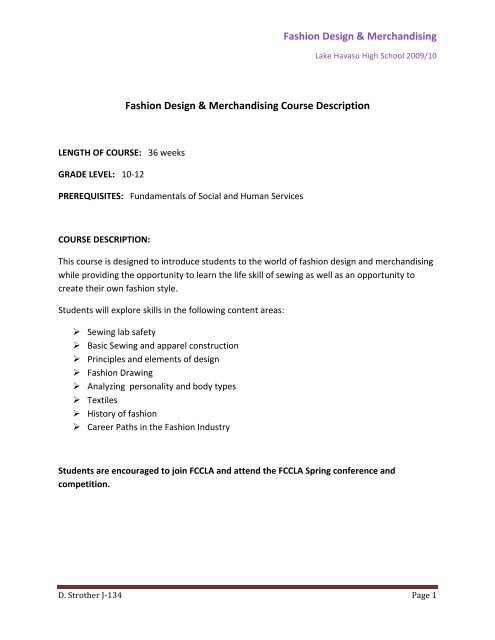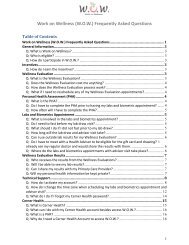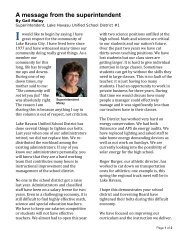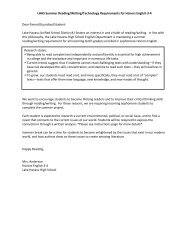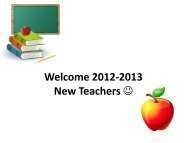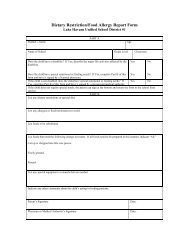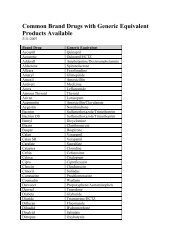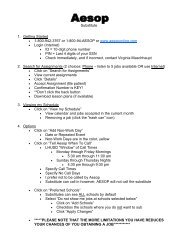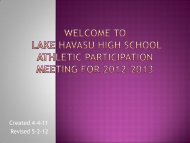Fashion Design & Merchandising - Lake Havasu Unified School ...
Fashion Design & Merchandising - Lake Havasu Unified School ...
Fashion Design & Merchandising - Lake Havasu Unified School ...
Create successful ePaper yourself
Turn your PDF publications into a flip-book with our unique Google optimized e-Paper software.
<strong>Fashion</strong> <strong>Design</strong> & <strong>Merchandising</strong> <br />
<strong>Lake</strong> <strong>Havasu</strong> High <strong>School</strong> 2009/10 <br />
<br />
<br />
LENGTH OF COURSE: 36 weeks <br />
GRADE LEVEL: 10‐12 <br />
<strong>Fashion</strong> <strong>Design</strong> & <strong>Merchandising</strong> Course Description <br />
PREREQUISITES: Fundamentals of Social and Human Services <br />
<br />
COURSE DESCRIPTION: <br />
This course is designed to introduce students to the world of fashion design and merchandising <br />
while providing the opportunity to learn the life skill of sewing as well as an opportunity to <br />
create their own fashion style. <br />
Students will explore skills in the following content areas: <br />
<br />
Sewing lab safety <br />
Basic Sewing and apparel construction <br />
Principles and elements of design <br />
<strong>Fashion</strong> Drawing <br />
Analyzing personality and body types <br />
Textiles <br />
History of fashion <br />
Career Paths in the <strong>Fashion</strong> Industry <br />
Students are encouraged to join FCCLA and attend the FCCLA Spring conference and <br />
competition. <br />
<br />
<br />
<br />
<br />
<br />
D. Strother J‐134 <br />
<br />
Page 1
<br />
Safety Procedures <br />
<br />
<strong>Fashion</strong> <strong>Design</strong> & <strong>Merchandising</strong> <br />
<strong>Lake</strong> <strong>Havasu</strong> High <strong>School</strong> 2009/10 <br />
Lab Safety <br />
Students will examine the equipment and tools used in the sewing lab and identify proper safety <br />
procedures for their use and care. <br />
Standard: 21.A‐ Establish safe use of equipment <br />
<br />
Workplace Safety <br />
Students will explore the responsibilities of professionals to create a safe work environment including <br />
precautions, ergonomic principles and safe use of basic equipment. They will also examine standards set <br />
by the American Disabilities Act, Uniform Federal Accessibility Standards and flammability and safety <br />
requirements. <br />
Standard: 13.0‐ Practice safe working procedures for a design and merchandising workplace <br />
4.5‐ Discuss ergonomics and how equipment is used in the design field <br />
<br />
<br />
Basic Sewing Techniques <br />
Measurement Tools <br />
Students will practice selecting and using common measurement tools used in design to make accurate <br />
measurements for several tasks. <br />
Standard: 12.0‐ Apply measurement techniques <br />
<br />
Sample Sewing Techniques <br />
The learner will make a sample notebook containing seventeen sample sewing techniques designed to <br />
give the basic sewing skills needed to construct a garment using a purchased pattern. <br />
Standard: 22.1a‐ Compare the quality of different clothing construction techniques <br />
<br />
<br />
D. Strother J‐134 <br />
<br />
Page 2
<strong>Fashion</strong> <strong>Design</strong> & <strong>Merchandising</strong> <br />
<strong>Lake</strong> <strong>Havasu</strong> High <strong>School</strong> 2009/10 <br />
<br />
<br />
Purchased Pattern <br />
Students will practice reading pattern directions for constructing a garment including proper layout and <br />
cutting techniques. The learner will be able to determine the amount of fabric needed as well as any <br />
notions needed by reading the pattern envelope. <br />
Standard: 22.2a‐ Interpret pattern direction for constructing textile items <br />
22.3a‐ Determine yardage, cost of fabric and other needs for selected pattern style and use <br />
22.4a‐ Perform pattern layout and cutting for garment construction <br />
<br />
<br />
Making a Garment <br />
Students will construct two simple garments using purchased patterns. These two garments are selected <br />
by the teacher and students will be lead step by step through the construction process. The learner will <br />
practice pressing techniques during the garment construction process. The student will be evolved in the <br />
evaluation of the fit and the quality of the sewing of their garments. <br />
Standard: 22.5a‐ Construct a garment using a pattern <br />
22.6a‐ Practice effective pressing techniques using appropriate equipment <br />
22.7a‐ Evaluate the construction a proper fit of garments <br />
<br />
<br />
<br />
Expressing Yourself <br />
Clothing and Your Image <br />
Students will explore how their clothing choices are used to express themselves and how that expression <br />
may affect how others perceive them. <br />
Standard: 18.1‐ Explain how people express themselves through the use of clothing <br />
<br />
<br />
D. Strother J‐134 <br />
<br />
Page 3
<strong>Fashion</strong> <strong>Design</strong> & <strong>Merchandising</strong> <br />
<strong>Lake</strong> <strong>Havasu</strong> High <strong>School</strong> 2009/10 <br />
<br />
Body Types <br />
The learner will examine the various body types and what design characteristics are best for each body <br />
type. Students will determine their personal body type and compare their current clothing choices to the <br />
proper choices. <br />
Standard: 18.2a‐ Identify body types and characteristics that influence the proper selection of clothing <br />
18.3a‐ Compare personal body characteristics when making clothing selections <br />
Illusions <br />
Students will be introduced to fashion illusions created by lines, texture and color. Through a series of <br />
pictures and samples of fabrics the learner will explore ways to create magic through design. <br />
Standard: 18.4a‐ Explain how an illusion of size can be created by the proper selection of fabric design <br />
and texture <br />
<br />
Accessorize <br />
The learner will explore the current trends in accessories. Students will create a bracelet or necklace to <br />
accessorize one of their garments. <br />
<br />
Standard: 16.3a: Explain how clothing and accessories communicate values <br />
<br />
<br />
Textiles <br />
Natural and Manufactured Fibers <br />
Students will examine the characteristics and history of several natural and manufactured fibers. After a <br />
PowerPoint lesson the learner will participate in burn tests to determine the fiber content of various <br />
fabrics. <br />
Standard: 20.1‐ Understand the history of fibers and fabrics <br />
20.2‐ Analyze characteristics of natural and manufactured fibers <br />
<br />
Fabric Construction <br />
The learner will evaluate fabric construction methods including knit, woven and pressed fabric. Using <br />
magnifying glasses students will identify the construction method used on several fabric swatches. <br />
Standard: 20.3‐ Identify characteristics of fabrics with various yarn constructions <br />
20.4‐ Evaluate woven, knit and other methods of fabric construction <br />
D. Strother J‐134 <br />
<br />
Page 4
<strong>Fashion</strong> <strong>Design</strong> & <strong>Merchandising</strong> <br />
<strong>Lake</strong> <strong>Havasu</strong> High <strong>School</strong> 2009/10 <br />
<br />
Choosing the Right Fabric <br />
Students will use the information learned in previous lessons and information on the pattern envelope to <br />
determine the proper fabric for a pattern. <br />
Standard: 20.6‐ Select appropriate fibers and fabrics for specific end users <br />
<br />
Labeling and Care <br />
The learner will examine various laundry products and procedures to determine how to safely use them <br />
on the correct fabrics. Students will look at clothing labels to determine proper care of several garments. <br />
In addition students will recognize the importance of noting the fabric content and care information <br />
when purchasing fabric for their projects. <br />
Standard: 20.7 Interpret labeling information to determine care procedures for various fabrics <br />
<br />
<br />
Leadership and Teamwork <br />
Communication Skills <br />
Students will practice skills needed to communicate with clients and co‐workers, identifying various <br />
barriers to good communication. They will also interpret verbal and non verbal communication using <br />
charades. Students will be asked to deal with a conflict or problem using effective written <br />
communication. <br />
Standard: 6.0‐ Practice effective communication skills for the design and merchandising workplace <br />
26.A‐ Demonstrate oral communication skills for the design and merchandising workplace <br />
<br />
Management Skills <br />
The learner will examine the characteristics of an effective leader as well as compare various leadership <br />
and management styles. Students will research a current business leader in the fashion world and write <br />
a short bio about that person to present to the class. <br />
Standard: 27.A‐ Demonstrate written communication skills for the design and merchandising workplace <br />
35.A‐ Evaluate leadership styles appropriate for the design and merchandising workplace <br />
<br />
D. Strother J‐134 <br />
<br />
Page 5
<strong>Fashion</strong> <strong>Design</strong> & <strong>Merchandising</strong> <br />
<strong>Lake</strong> <strong>Havasu</strong> High <strong>School</strong> 2009/10 <br />
<br />
<br />
Team Project <br />
Students will participate in a team project as the practical portion of their first semester final. Each class <br />
will be divided into three teams. They will be assigned a client, a work order for a garment, and a <br />
deadline. The teams will receive supplies needed to complete the job but must prepare a work plan and <br />
schedule to meet the deadline. Teams will assign duties including a team leader, and will work together <br />
to solve any problems that may come up. Students will be asked to individually evaluate team project, <br />
themselves and their team member’s contributions to the project. <br />
Standard: 9.0 Apply problems solving and decision making processes to design & merchandising <br />
situations <br />
<br />
<br />
<br />
<strong>Fashion</strong> and Human Behavior <br />
Society and <strong>Fashion</strong> <br />
Students will examine recent changes in family structures, the family life cycle and cultural differences <br />
and the impact they have on fashion decisions. In addition they will explore the impact of the economic <br />
and physiological changes on the fashion industry. <br />
Standard: 5.0 Analyze family units based on social, cultural, physiological, economic and psychological <br />
factors as they relate to clothing and housing needs. <br />
<br />
<br />
<br />
Physical Attributes <br />
The learner will identify how body measurements, disabilities and physical attributes influence clothing <br />
designs and decisions. <br />
Standard: 4.4‐ Identify anthropometrics and how they affect designs <br />
4.6‐ Explain how disability and physical attributes influence clothing designs or human <br />
environments. <br />
<br />
<br />
<br />
<br />
D. Strother J‐134 <br />
<br />
Page 6
<strong>Fashion</strong> <strong>Design</strong> & <strong>Merchandising</strong> <br />
<strong>Lake</strong> <strong>Havasu</strong> High <strong>School</strong> 2009/10 <br />
<br />
<br />
Principles and Elements of <strong>Design</strong> <br />
Identifying Principles and Elements of <strong>Design</strong> <br />
Student will examine the principles and elements of design through a PowerPoint presentation that <br />
details each principle and element. The learner will present examples to the class using pictures and <br />
discussion. <br />
Standard: 19.1‐ Identify key elements and principles of design <br />
<br />
Color as a <strong>Design</strong> Element <br />
Students will consider how color impacts design by exploring how hue, value and intensity are used to <br />
illustrate various design themes. Using a croquis students will draw and color a garment and be prepared <br />
to discuss the impact the colors made on the design. <br />
Standard: 19.3‐ Demonstrate an understanding of the color principles <br />
19.4‐ Differentiate between hue, value and intensity <br />
19.5‐ Consider how color impacts design <br />
19.7‐ Select specific hues to illustrate color principles in various design themes <br />
11.0‐ Demonstrate drawing and visualization skills required for design and merchandising <br />
<br />
Using the Principles and Elements of <strong>Design</strong> <br />
The learner will demonstrate the use of the principles and elements of design by constructing two <br />
garments using a purchased pattern. Students will choose patterns, fabric, colors, and trims that are best <br />
for their body type. <br />
Standard: 19.2‐ Demonstrate the use of the basic design elements and principles <br />
19.6‐ Assess the elements and principles of design utilized in textile products <br />
<br />
<br />
<br />
<br />
D. Strother J‐134 <br />
<br />
Page 7
<strong>Fashion</strong> <strong>Design</strong> & <strong>Merchandising</strong> <br />
<strong>Lake</strong> <strong>Havasu</strong> High <strong>School</strong> 2009/10 <br />
<br />
<br />
Ethics and Laws <br />
Contract Law <br />
Students will be able to explain the basic concepts of contract and consumer law after a PowerPoint <br />
lesson and will practice what they have learned by conducting a mock court where they will examine <br />
several scenarios related to the fashion industry. <br />
Standard: 14.1 Explain the basic concepts involved in contract law consumer law, and consumer credit <br />
and protection <br />
<br />
<br />
Consumer Credit <br />
The learner will examine various types of consumer credit including interest rates, fees and regulations <br />
meant to protect the consumer. <br />
Standard: 14.1‐ Explain the basic concepts involved in contract law, consumer law, and consumer credit <br />
and protection <br />
<br />
<br />
Ethics <br />
Students will compare ethics and laws in the fashion industry by discussing the difference between <br />
knockoffs of designs and copyrighted logos. The learner will write an essay examining the problems <br />
related to maintaining ethical standards in the fashion industry. <br />
Standard: 14.2‐ Define code of ethics for a design and merchandising environment <br />
14.3‐ Examine the relationship between ethics and the law for the design and merchandising <br />
Industry <br />
<br />
14.4‐ Examine the problems related to maintain ethical standards in situation without a clear <br />
standard <br />
<br />
<br />
<br />
<br />
D. Strother J‐134 <br />
<br />
Page 8
<strong>Fashion</strong> <strong>Design</strong> & <strong>Merchandising</strong> <br />
<strong>Lake</strong> <strong>Havasu</strong> High <strong>School</strong> 2009/10 <br />
<br />
<br />
Term Paper <br />
Small Business and the Economy <br />
Using the internet students will research and write a two page typed report on the role of small business <br />
on local, state, national or international economics. In their paper they will list the factors which <br />
contribute to success in small business and compare/contrast the advantages and disadvantages of sole <br />
proprietorships, partnerships and/or corporations. The paper will also analyze the relationship of <br />
customer service and customer satisfaction on the success of a business. Students will email their term <br />
paper to the teacher <br />
Standard: 28.A‐ Evaluate the role of a small fashion design and merchandising business in the economy <br />
8.0‐ Demonstrate technological literacy for the design and merchandising workplace <br />
<br />
<br />
Careers in <strong>Fashion</strong> <strong>Design</strong> and <strong>Merchandising</strong> <br />
Career Plan <br />
Students will explore traditional, non‐traditional, and entrepreneurial careers in fashion design and <br />
merchandising. As a class we will identify trends in design and merchandising related occupations <br />
including wages, locations, and education required. Students will be asked to relate their interests, skills, <br />
and attitudes to one of the careers discussed. <br />
Standard: 1.0‐ Explore a career plan in design and merchandising <br />
<br />
Job Search and Employability Skills <br />
Students will research employment opportunities for the career they related to most. They will find an <br />
application on line and critique it in hard copy. In class students will explore the factors contributing to <br />
job success such as ethical behavior, social skills, professional dress and interviewing skill. Students will <br />
update their resumes and practice interviewing skills. <br />
Standard: 2.0‐ Practice employability skills required for a design and merchandising opportunity <br />
3.0‐ Develop job search skills for the design and merchandising industry <br />
<br />
<br />
D. Strother J‐134 <br />
<br />
Page 9


